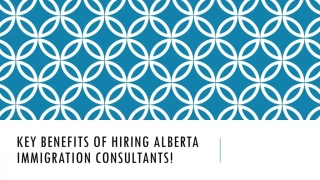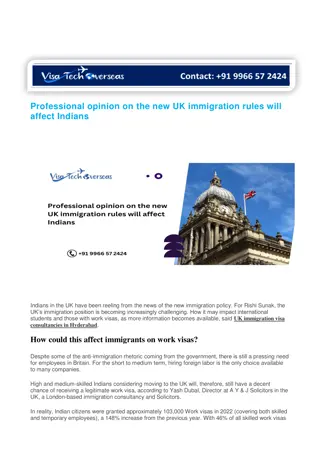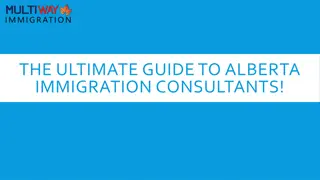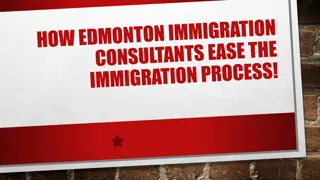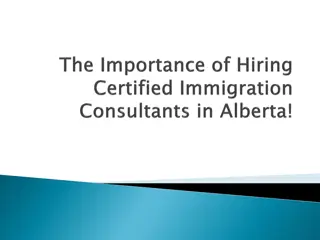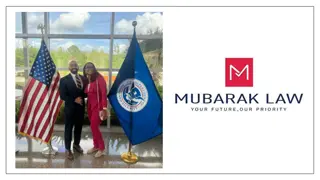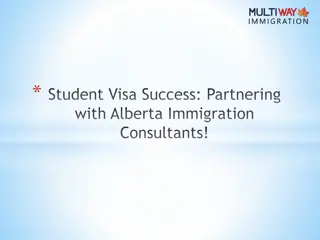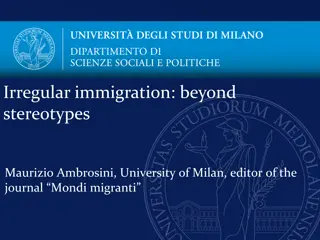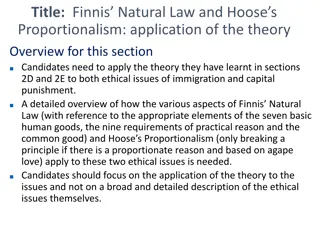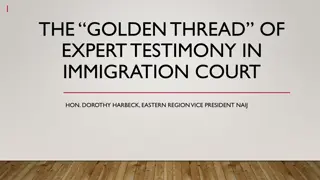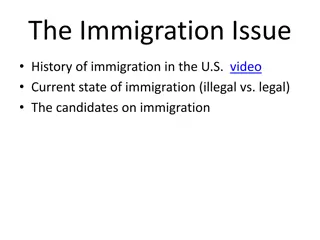Understanding Immigration Options for International Students
Learn about immigration options for international students, including advice on navigating the process, basic vocabulary, employment restrictions, and opportunities like Optional Practical Training (OPT). Stay informed to make the most of your educational journey in the US.
Uploaded on Sep 13, 2024 | 0 Views
Download Presentation

Please find below an Image/Link to download the presentation.
The content on the website is provided AS IS for your information and personal use only. It may not be sold, licensed, or shared on other websites without obtaining consent from the author. Download presentation by click this link. If you encounter any issues during the download, it is possible that the publisher has removed the file from their server.
E N D
Presentation Transcript
Working it Out: Immigration Options Kathleen Gasparian Gasparian Immigration 504 262 9878 kathleen@gasparianimmigration.com
WARNING WARNING WARNING The information contained in this presentation is intended to educate members of the public generally and is not intended to provide solutions to individual problems. Readers are cautioned not to attempt to solve individual problems on the basis of information contained herein and are strongly advised to seek competent legal counsel.
Some General Advice Get to know your international office and/or designated school official. Your friend or cousin is usually not a good source for information about immigration. Only get immigration advice from your international office and/or an experienced immigration attorney. Be prepared. Always be thinking of the next steps of your immigration journey.
Basic Vocabulary Visa vs. Status Non-immigrant status vs. Immigrant Status Permanent Residence
Before You Graduate F-1 students have limited ability to work while pursuing a degree: 20 hours per week on campus and possible options of curricular practical training. Use your limitations to your advantage - research and prepare - network, network, network - get involved
The First Step Optional Practical Training = OPT OPT is your chance to get in with an employer, find an employer to sponsor you, or just time to lay the foundation of your empire. Acts as a transition between your studies and your career. Work closely with your international office to ensure timely and proper filing. Think strategically about your graduation date and OPT application date.
Regular Post-Completion OPT F-1 students are eligible for one year of OPT after each higher degree. Does not require a job offer to apply; no requirements for employer. Apply up to 90 days before completion of program and up to 60 days after completion of program. The one year of OPT must finish within 14 months of completion of program.
Regular Post-Completion OPT Cannot begin working on OPT until card received. The card takes 90 days. Employment must be directly related to major field of study. Can be any position that is directly related to major and commensurate with degree level. Allowed 90 days cumulative of unemployment.
Maintaining Regular OPT Must be employed! Must be at least 20 hours per week. May work for more than one employer all must be related to field. May work as an independent contractor. Self employed must show business license and related to degree. Volunteer or unpaid internship as long as it is at least 20 hours a week Authorization automatically terminated if you transfer to another school or begin study at another level Must report name change, address change, and gaps in employment to DSO
Educating An Employer About OPT Does not require the Employer advertise, enroll in e-verify, or submit forms or petitions to USCIS. Only provides for one year of work authorization, so if they like you, they will need to take additional steps. Small employer vs. large employer What is the advantage?
STEM OPT Allows some students with U.S. science, technology, engineering, or math degrees to apply to extend their post-completion OPT authorization for 24 months (total of 3 years) What counts as a STEM field has been expanded. Check with your DSO right away! Two 24-month STEM extensions may be granted per lifetime, based on completion of an advanced degree level.
STEM OPT While you can get regular OPT after each successively advanced degree, only get 2 STEM OPT per lifetime. Can use prior degree as basis for STEM extension. i.e. MBA now and bachelor degree in a STEM field can do an extension now. Can t stack STEM OPT to get 6 consecutive years. Can only do one STEM OPT per degree.
STEM OPT Basic Eligibility Be employed or have a job offer (directly related to your field of study) from an employer who is registered in the USCIS E- Verify Program. Employer completes and signs Form I-983. Must be a bona fide employee, so unpaid/ volunteer not allowed. File within the required timeline within 90 days prior to expiration of OPT.
STEM OPT Employer Responsibilities Be enrolled in E-Verify and remain in good standing. Report material changes to the STEM OPT student s employment to the DSO within 5 business days. Implement a formal training program to augment the student s academic learning through practical experience. Provide an OPT opportunity that is commensurate with those of similarly situated U.S. workers in duties, hours, and compensation.
STEM OPT Employer Responsibilities Complete the Form I-983, Training Plan for STEM OPT Students: They have enough resources and trained personnel available to appropriately train the student; The student will not replace a full-or part-time, temporary or permanent U.S. worker; and Working for the employer will help the student attain his or her training objectives.
STEM Responsibilities (Foreign National) Submit report to DSO every 6 mo. Verifying: name, address, employment Complete 2 self evaluations 1st- within 12 months of STEM OPT start date 2nd at end of STEM OPT period Cannot be unemployed for an aggregate of more than 150 days.
STEM OPT and Employer Issues Employer may not want to enroll in e-verify for STEM extension or to the STEM training plan/ attestations. Know your industry. Know your potential employer. myvisajob.com; immihelp.com; database of past H1B or PERM employers Be able to explain potential benefits to employer.
Best Practices for OPT Get to know your international office (DSO). Go to the OPT workshops. Be cautious about travel on OPT understand where you are in the process and possible consequences. This is especially true if you are also pursuing H-1B status or residence. Skip OPT?- only a few scenarios where that might be advisable. If you don t apply timely for OPT, you miss the chance to have it. Will probably want to apply anyway as a Plan B.
H-1B The primary work visa/status. Designed for professional positions those that require at least a bachelor s degree. The employer (not the foreign national) applies or petitions with USCIS for the visa/status. It is employer and position specific. The position and the foreign national must qualify.
H1B The Basics H1B status is generally limited to six years. You may be able to extend beyond the six years if certain steps towards permanent residence are taken timely. A petition can be filed for up to 3 years at a time. You may hold more than one H-1B at the same time, and H-1B employment can be part-time. Employment must be directly related to degree (current or prior).
H1B The Basics H-1B visa/status allows for the intent to become a permanent resident. Allows for spouse and children to have H-4 status. H-4 only can have work authorization in limited circumstances. Very portable once you are on H-1B easy to change employer and extend.
H-1B Employer Obligations Employer is required to make attestations to both the Department of Labor and USCIS. - the job is real and foreign national will be employed as set out in petition - agrees to employ the foreign national only in the position/location - agrees to offer to pay return transportation to country of nationality if the H-1B is terminated early
H-1B Employer Obligation - Employer does NOT have to recruit/ show no US workers - Has to post information about the position and wage in- house and may have other notification requirements to other workers - The must be no strike or lockout The H-1B is not an employment contract!
H-1B Employer Obligations The Wage Must agree to pay higher of actual or prevailing wage (aka required wage ). Actual wage: wage paid to other similarly employed and similarly qualified workers at same worksite. Prevailing wage: weighted mean or median wages for similar positions in geographic area of employment. Basically, this means that a competitive wage must be offered. There are four levels of wages and separate wage data for higher-ed and certain other employers. See: www.flcdatacenter.com
Filing Fees Current USCIS filing fees for H-1B petitions are: $460.00 basic filing fee (for Form I-129) (increasing to $460 in 12/2016) $500.00 anti-fraud fee (not for extensions) Training fee (ACWIA) $750.00 (employers of fewer than 25 full-time employees) or $1500.00 (employers of 25 or more full-time employees) Higher ed. institutions, primary/secondary schools, non-profit and U.S. govt. research entities are exempt from training fee Additional $1,225.00 for optional premium processing PL 111-230 creates 50/50 rule certain employees will have to pay additional $2,000 for H-1B and $2,500 for L-1A
Who pays for legal and filing fees? If the employee earns more that the required wage, the employee may be able to pay some or all of the legal and filing fees (excluding the training fee). Employee cannot pay legal/filing fees if it reduces his/her wage below the required wage. Having employee pay fees that he/she should not can result in fines, assessments of back pay, and disbarment from the H1B petitioning process.
H-1B Process Analyze whether H-1B status is proper for the position and the employee Determine prevailing wage for job File Labor Condition Application with DOL File H-1B petition with USCIS If employee is in the U.S., USCIS will change status to H-1B (no need to leave U.S. usually) Obtain proper status (H-4) for dependents Extensions, if necessary Change of Employer ( transfer ), if necessary
The CAP! USCIS makes H-1Bs available October 1, the start of its fiscal year 65,000 generally available Additional 20,000 for graduates of US Master s degree programs *** As long as you have a US Masters, can participate in master s quota even if job relates to different degree. Higher education institutions and affiliated non-profits exempt U.S. Government and non-profit research organizations exempt Petitions may be filed 6 months in advance, on April 1 ******Lottery Process*******
Cap Gap Cap Gap is the gap between the end of OPT and the start of H-1B that many students face because they start OPT in June and H-1Bs usually unavailable until October 1 Regulations If employer files an H-1B petition requesting change of status for you before your OPT expires, then your OPT work authorization and D/S (F-1 status) are extended until 10/1 The approval notice will indicate grant of a change of status effective October 1 If there s a lottery, and your employer s petition is not selected, when OPT ends you have a 60-day grace period to remain in the U.S. (can t work during grace period)
Planning for H-1B Status Apply for OPT (and strategic) manner Know the prevailing wage for your position/area. Know if the employer has sponsored for H-1B in the past. Talk to your employer early H-1B cap problems make this essential How you handle the discussion depends on the situation Issues to settle Who will handle the petition process Remember, it is the employer who files the petition Some employers use a specific attorney, some have in-house experts, some will allow you to hire the attorney, others have no idea about any of this Do not let your petition be your company s first self-filed H-1B petition Who will pay the legal fees and filing fees? If your employer s petition is not selected, what will you do?
Other issues to think about Many entry level jobs do not require a degree especially sales, certain management training, and some human resources positions. Jobs that pay based on commission or sales may not be able to meet the wage requirements. Paying a company to file for you when you have no intention of working for them is FRAUD can jeopardize your future in the US. Startups, financially troubled businesses, and those that take a tax loss each year may work for the H-1B, but may have trouble in the process for permanent residence.
Once you have H-1B status H-1B allows dual-intent Can extend status in the US without going abroad Can have concurrent employment if second employer also files an H1B petition Can easily change employment if second employer files an H-1B petition - ****Issues if moving from cap exempt to cap subject Remember if you don t pursue permanent residence, only get 6 years in H-1B Start the process for permanent residence before the end of your 5thyear to ensure ability to keep extending H-1B status.
Business Ownership and H-1B H1B petitioner must be separate legal entity from beneficiary. Petitioning company must have independent board with power to discipline and fire beneficiary. May ask for proof that prevailing wage will be paid: good business plan and immediate income stream Consider E or L instead of H (discussed below). Even if H approved, usually a dead end , because business owners cannot sponsor themselves for permanent residence (except large investors, discussed below).
Other Non-Immigrant Options Country Specific Options: TN (Mexico and Canada), E-3 (Australia), H-1B1 (Chile and Singapore) Treaty Investor or Treaty Trader E-2 Multinational executive/manager or specialized knowledge L-1A/L-1B Religious Worker R-1 Extraordinary Ability or Artists O-1 H-3 trainee H-2B seasonal / periodic J-1 options? beware 212(e) B-1 (tourist for business) VERY VERY LIMITED
E Visa: Treaty/Trader Visas U.S. company must have nationality of a treaty country Employee must be a national of the same treaty country Employee must be engaged in managerial duties or have essential skills E visas granted for an initial period of up to 5 years and subsequent extensions are available (Petitions granted 2 years) Spouses eligible to apply for employment authorization
E Visa: Treaty/Trader Visas There are two kinds of treaty/trader visas E-1 for import/export business E-2 for all 50% ownership and substantial investment Depends on treaty with your country as to what is available Keys to success a really good business plan and clear evidence of funds. Is my country on the list? http://travel.state.gov/content/visas/english/fees/treaty.html
O-1 Requirements Alien must be one of the small percentage who have arisen (sic) to the very top of the field of endeavor. Position must require utilization of extraordinary ability Employment limited to petitioning employer No portability if in O status, upon filing of new petition, until new petition approved For artists think in broad terms standard is different/lesser. Must have an agent/petitioner cannot self petition
TN Visa Available to citizens of Mexico and Canada Occupation must appear on NAFTA list Given in three year increments, no limit Canadians need only present one year job offer, credentials at border or airport for admission Mexicans must follow H-1B-like procedures Extensions may be done within US
Thinking outside the box Educate yourself and your employer about back up plans Can your employer partner with a University in such a way to create concurrent employment? Are you eligible for TPS? (Yemen, Nepal, etc.) Are there options for your spouse that lead to work authorization for you? (i.e. can your spouse obtain an investor visa which allows for work authorization for spouse?) Can you work abroad for the employer until an H or PR can be secured? Back to school and CPT? Jump ahead to permanent residence?
Other Alternatives Permanent Residence Employment Through an employer Self petition Close Family Spouse, Parent, Child over 21, sibling (very long wait) Asylum Military Service (MAVNI) Diversity Visa Lottery if possible, have both you and spouse apply and increase your chances Money (Large investment) Removal Proceedings
How long does permanent residence take? Process to permanent residence can be lengthy (years), not because the processing with the government is lengthy but because the demand for immigrant visas exceeds the supply. The higher in preference, the shorter the line.
Changes to the Visa Bulletin In September DOS made big changes to the Visa Bulletin Seemed to be a coordinated effort with USCIS Both agencies had publication/information The October bulletin was the first of the new process Each category has two different charts of dates One chart is the same as before and termed Date for Final Action The second chart has earlier dates and is called the Dates for Filing Applications As originally published, the October bulletin had some crazy dates for Dates for Filing . So, a revised October bulletin was issued before October 1 with much later dates Kerfuffle, Lawsuit, Mayhem October 14, 2015 USCIS states Beginning with the November 2015 Department of State (DOS) Visa Bulletin, if USCIS determines that there are more immigrant visas available for a fiscal year than there are known applicants for such visas, we will state on www.uscis.gov/visabulletininfo that applicants may use the Dates for Filing Visa Applications chart. Unless otherwise stated on our website, the Application Final Action Date chart will be used to determine when individuals may file their adjustment of status applications. And we will do it within one week of DOS putting out the visa bulletin
Immigration through Employment First Preference: Extraordinary ability or achievement in sciences, arts, education, business, or athletics; Outstanding professor/ researcher; Certain multinational executives/ managers Second Preference: Professionals with advanced degree; Aliens of exceptional ability; National interest waiver of job offer and labor certification for professional with advanced degree or alien of exceptional ability
Immigration through Employment Third Preference: Skilled workers - Members of the professions holding minimum of Bachelor s degree or where job requires at least two years education, training or experience Other workers (where job requires less than two years education, training, or experience). Generally requires PERM except nurses and physical therapists
Immigration through Employment - the very simple version- Step 1 The employer demonstrate to the DOL that there are no qualified US workers (called PERM) For certain jobs/positions/aliens this step can be skipped. Step 2 Petition filed with USCIS (the I-140) In most cases, filed by the employer. Sometimes, the alien can self-petition. Step 3 The application for permanent residence There has to be a spot available
Who Pays? ALL PERM costs must be borne by Employer Includes atty s fees and costs Includes advertising costs Employer cannot require employee to pay back Foreign national CAN pay fees and costs for the parts of the process that come after the PERM (i.e. can pay for the I-140 or adjustment of status).
Skipping H and Jumping to PR while on OPT Timing is a big issue Employer must be willing to bear cost, etc Difficult for recent hires May be an option in a high demand field Unlikely that the process will get you to a work card during 1 year OPT, definitely a possibility if you are STEM and start at the beginning of your time in OPT (unless from India and China) Must understand preference and visa bulletin
Can I sponsor myself for permanent residence? - First-preference : have to show alien of extraordinary ability = international acclaim - Second-preference: have to show advanced degree and national interest. - A very recent case changes the standard USCIS applies and makes it easier for entrepreneurs, business developers, etc. to self petition under this category.




